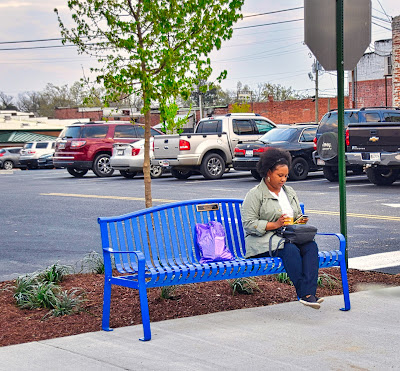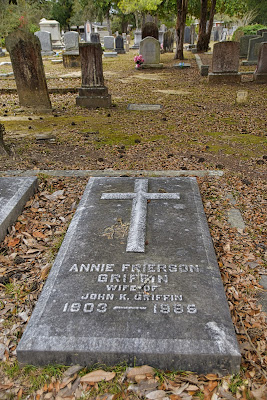This week, we'll focus a little less on history and a little more on history-in-the-making. I don't know for certain, but I think it might be a safe bet to say that Academy Street had never spent an evening before last Thursday filled with beautifully-decorated tables as residents strolled from business to business to the strains of that most American of all music, jazz, while shopping, and in some of the businesses, sampling the food that was a part of Kingstree's first Downtown Dine Around.
Tables waiting for the Downtown Dine Around to begin.
Diners gathered with friends and neighbors around tables on Academy street
during Kingstree's first Downtown Dine Around
It's good for a community to take a break from the hustle and bustle of everyday living and spend an evening with friends, neighbors, and acquaintances, while at the same time slowing down the pace enough to absorb what's been happening while we've all been busy with our daily lives.
Main Street Director William Freeman and Design Committee member Frances McGill Belser
set up a table and chairs in front of Artsy Bakery, one of the newer businesses on Academy Street.
A table in Welch Park offered beer and wine as well as tea and water
to Downtown Dine Around ticket holders.
In the last six to eight months, at least four new businesses have opened downtown. Academy Street is now home to Miles & Co., Artsy Cakes & Bakery, and Shirley's Floral Gifts, while on Main Street, Donna's has opened in the old fruit stand.
The new maple trees in the Downtown Parking Lot are welcoming spring with
plenty of new leaves.
The Downtown Parking Lot has undergone a complete makeover and was filled to capacity with cars and trucks at Thursday night's event. The maple trees in the new planters in the parking lot are full of tiny spring-green leaves. Also, shoppers are taking advantage of the new benches flanking the Academy Street entrance to the parking lot to rest for a few minutes, to visit with friends, or to check their phones.
A shopper checks her phone while resting a few minutes on one of the Academy Street benches.
The HomeTown Chamber recently completed a facade makeover, and new banners are flying from the light poles on Main and Academy Streets.
One of the new banners in front of the HomeTown Chamber office on Academy Street.
Another of the new banners and balloons welcomed Dine Around participants
to Academy and Main streets.
Main Street also drew crowds during the Downtown Dine Around.
To many people, progress seems to take a long time, and it is a slow process. But the signs are visible in downtown Kingstree, and there is more to come. If you missed the Downtown Dine Around, you may want to mark your calendar to attend the Easter Eggstravaganza from 10 a.m. until 2 p.m. on Saturday, April 13. There will be a huge downtown Easter egg hunt, and the Easter Bunny will be on hand to have his photo taken with children. This event will kick-off a week-long promotion among participating merchants in which anyone making a purchase will be given a chance to win prizes.
I read recently that each town has its own particular magic, depending on the lens through which we choose to view it. Our own particular magic was on display last Thursday night. More visible changes are on the way, so keep your eyes and ears open as you visit downtown Kingstree over the next month or so.

















